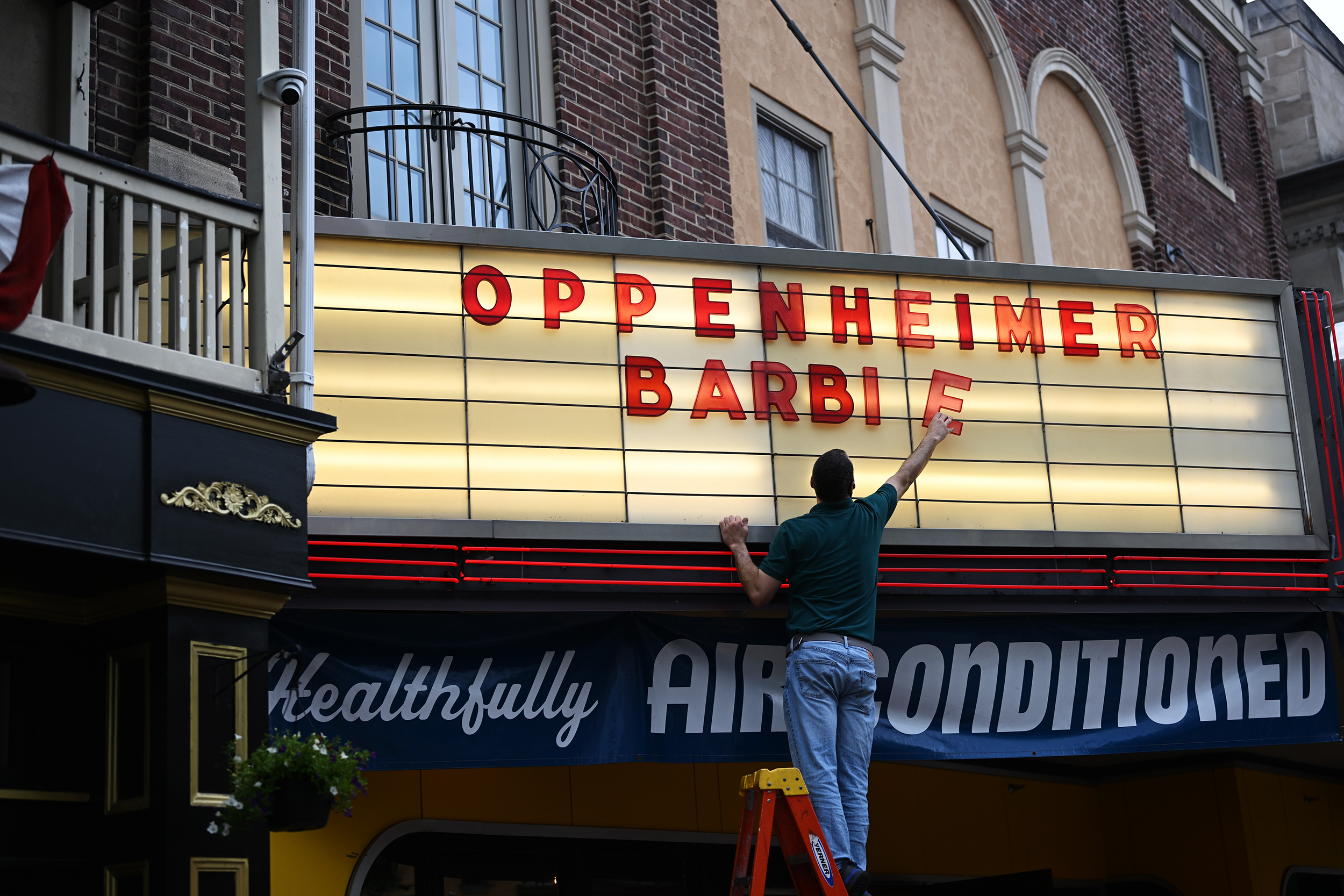By Max Shanagher.
One existential crisis in a day usually causes me to sit rocking back and forth in a dark room. Two existential crises in a day causes me to rock back and forth for a week. Now, finally, I have emerged from my fugue state and turned the lights on in my room. What was the cause of this state? Social media’s insistence that I go and see the films Barbie and Oppenheimer on the same day.
Reluctantly, I admit that I failed to see them back to back. I wanted to see Oppenheimer in its intended IMAX format and sadly Barbie didn’t have any showings which paired up to the allocated time slot. So I had to plan my day: there were two options to follow.
See Oppenheimer first in the morning, accompanied by a black coffee and a cigarette. Leave Oppenheimer and go and sit in a park for two hours, staring at the birds and the trees. Then get a pre-planned call from a friend, asking if you would like to go to a bar and have a nice cocktail or two. Once enjoying this pre-planned buzz of social reacceptance, going to the bar and getting a little bit drunk. Not so drunk that I would fail to appreciate the golden age of Hollywood-inspired glamour of Barbie, but drunk enough that I am able to put a veil over my eyes that avoids Mattel’s obvious attempts to kick start their own toy cinematic universe. I would exit Barbie cheering and whooping. What fun.
I decided against this. I woke up, and put on the best Ken costume I could find. Quickly fast forwarding through the trailer, I established that Ryan Gosling’s Ken’s job in the movie is the elusive ‘Beach’. So for inspiration, I picked out a combination sported by many Durham students on the sunny beaches of Seaham and Crimdon. Pink shorts and a cream linen shirt. I walked down the street to see people blinded by my Kenergy. Somebody fainted so I had to call an ambulance. We arrived at the cinema, accompanied by two small tins of some ambiguously named cherry cocktail, and sat back for the movie. What a bizarrely fun movie it was — highlights being Margot Robbie’s inability to ugly cry (more ugly crying will appear later) and a highly coordinated dance off between Ryan Gosling and Simu Liu. I emerged from the movie with a big grin on my face. I then looked at my phone.
The far-right on Twitter had decided that the portrayal of Ken was a demeaning portrayal of their masculinity and Ben Shapiro had created a forty three minute video DESTROYING Barbie. I think what occurred here was more Greta Gerwig DESTROYING them; a grown forty year old man sitting in front of a camera complaining for forty minutes shows that the film touched a nerve. Gerwig not only creates a matriarchal Barbieland lacking wars or hatred (suggesting how the patriarchal ascription of some notions of violence to masculinity has caused some problems) but also shows through the disaffection of Kens the importance of the universal equality of the sexes. It was an advert, a well executed advert with genuine feeling and a strong feminist message but an advert nonetheless. Admittedly, if anyone would like to sponsor me to get an ‘I am Kenough’ jumper for 60 dollars, message me and I’ll give you my PayPal. How the far-right could be so affected by an advert demonstrates the power of the movie in itself, by responding to it with such hatred they have shown the problems with the values which they so admire.
Much like Superman changing into his super suit in a telephone box, I chose the Vue Cinema toilets to be my location where I switched into my Oppenheimer garb. Gone were the contact lenses, flicked out with reckless abandon and replaced with tortoise shell glasses. I stripped off my pink shorts and replaced them with jeans and accompanied the shirt with a black turtleneck. Apart from embracing chelonian clothing (a word I have discovered, which means turtle and tortoise-like), I was embracing a more intellectual look. Less successful than my Ken outfit, to my dismay, I arrived at the IMAX five hours later to see people wearing lab coats and Oppen-styled hats. I was a fashioned embarrassment, munching popcorn in an over-hot jumper.
The popcorn munching began five minutes into the movie because the queue to the concession stand created a general crush outside of the IMAX doors. If anything happened of note in the first five minutes please do let me know, I was very sad to miss it (Mum and Dad I have to blame you for your insistence that my girlfriend and I could carry all the snacks, there were too many snacks, far too many snacks). Once the movie began, I was mesmerised. The three hour run-time passed surprisingly quickly, with no points at which I felt it was dragging too long. The sound design, I thought, was the best part. In typical Nolan-style it was difficult in parts to hear dialogue but I couldn’t care less as I felt the blast-wave of an Atomic bomb just by its sound. Cillian Murphy’s performance was brilliant; worries for a brooding Tommy Shelby with an American accent were quickly displaced. I’ve enjoyed afterwards watching Robert Downey Jr’s promotional material for the film. Nolan challenged Downey Jr to perform as the ‘Salieri’ to Oppenheimer’s ‘Mozart’, and I thought through this premise the intrigue was sustained through to the film’s conclusion.
Once again, I picked up my phone upon leaving the cinema to read Twitter. This time, more liberal voices argued that Nolan failed to give voice to the Native Americans and Japanese people who were affected by Oppenheimer’s actions. I agreed with the lack of voice given to Native Americans who were displaced in Los Alamos; they were reduced to a few throw-away lines and Oppenheimer was obviously aware of their presence by suggesting upon the closure of Los Alamos that the ground be restored to them. I disagree with the argument that it lacks a Japanese voice. The reason I disagree is because I thought that the movie captured the genuine American nationalism that was occurring during the war through the lead up and the fallout from the nuclear bombings. It would have been interesting to portray Oppenheimer’s visit to Japan in 1960, particularly because it occurs only a year after Strauss’ nomination by Eisenhower (which the film covers).
Japanese film has captured the impact of the war on the citizens of Japan so strongly that they could be shown as perhaps a much stronger accompaniment to Oppenheimer than Barbie. I watched Studio Ghibli’s Grave of the Fireflies when I was 10 and living in Japan. I would suggest not showing the film to a ten year old because I cried for weeks, and every time I have watched it since, I have cried in a way that would put Margot Robbie to shame. Nolan succeeded in capturing the scariness of American nationalism both in the ease with which the decision is made to drop the bomb (to the despair of petitioning scientists), and the ease with which a new enemy is created through Mccarthyism.
Nolan himself created an enemy out of Warner Bros in 2021 when criticising their new HBO Max streaming service. He was so critical that he gave Oppenheimer’s distribution rights to Universal rather than Warner Bros. This decision, perhaps, caused Warner Bros to move their tentpole film of the summer, Barbie, to the same weekend as Oppenheimer. Rather than creating the monopoly on the box office weekend that they intended, both films performed well at the box office because of the Barbenheimer trend. Barbie had the biggest opening weekend for a female director whilst Oppenheimer has already surpassed Nolan’s previous film Tenet in ticket sales after two weeks.
These successes demonstrate how social media can both give and take. The criticism of the films, whether valid or not, gained significant traction. Ben Shapiro’s forty minute rant has gained 2.3 million views on Youtube. A comment on Twitter about the underrepresentation of Japanese voices in Oppenheimer gained 75k likes and many more interactions. On the more positive side of things (and one of the reasons I have left my room), social media has effectively countered Warner Bros’ attempt at undermining Nolan’s box office presence. In the wake of both the writing and acting strikes, which have affected both films’ promotional runs, the crazy event that is Barbenheimer suggests that the audience has more agency in which films it chooses than movie executives would believe. A movie populated by AI writers and AI actors is not an artistic feat, but both these movies are. Unless, of course, you’re Ben Shapiro.



